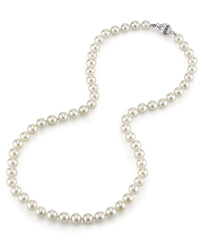
Japanese Akoya White Pearl Necklace, 6.5-7.0mm - AAA Quality
$1,540.00 Sale: $1,232.00


MARVELOUS METALLICS
These lustrous Metallic Freshwater pearls were simply out of this world beauties. Spotted at the Hong Kong Gem and Jewellery Show.

Every day we receive questions from customers all over the world about pearls. We decided to post our answers here for every one to read!

These realistic imitation pearls are all extremely uniform in color, but there are other tell-tale signs that these are man-made, and not genuine cultured pearls!
When purchasing pearls, it is essential to learn how to tell the difference between real cultured pearls, and man-made, synthetic pearls.
There are many different types of man-made imitation pearls, and the techniques used to create them are constantly evolving, releasing new types that are more and more difficult to distinguish from the real deal.
The types of imitation pearls you should learn to recognize are:
Mallorca or Majorica Pearls
Shell Pearls - also called Mother of Pearl Pearls
Bathed Pearls
Swarovski Crystal Pearls
Glass Pearls
Plastic Pearls
The most important distinguishing factor to realize when evaluating pearls to learn whether they are real cultured pearls, or artificial pearls, is that the man-made pearls are are almost always extremely uniform in appearance ... a far cry from the lovely and subtle natural variances of the biological origins of real pearls, natural or cultured!

Always inspect your pearls carefully!
One of the most effective and easy ways to tell the difference between cultured pearls from artificial pearls is to simply closely inspect them with your eyes.
We recommend putting your pearls on a plain white piece of printing paper, using indirect mid-morning light as the best setting for examining your pearls. Bending close (about 6-inches away) slowly begin rolling sections of the pearls in front of you, watching for the tell-tale signs that your pearls are the genuine article.

The cultured Akoya pearls above show subtle differences in body color, overtone, orient (rainbow iridescence) and some slight mottling on the surfaces indicating thick nacre layers.

Real cultured pearls have a nice heft and weight to them.
This one is a bit more subjective, as it is based entirely upon feel, but real cultured pearls will feel heavier and have a heft to them that imitation pearls do not.
If you have a strand of pearls you know are genuine and a strand you know are fakes, weigh them against each other in each hand, and usually you'll be able to tell the difference!
Exceptions to this rule would be Majorica pearls and Shell pearls, which are created using either a glass core with layers of iridescent coating, or a mother of pearl core similarly coated giving them a realistic weight.

The Tooth Test is not as sexy as this looks.
One of the oldest and simplest ways to test whether your pearls are genuine is the Tooth Test. To perform the Tooth Test, gently (gently!!) rub or bite the pearls between your front and bottom teeth, and scrap them along the curved surface of the pearls.
What you're looking for is a gritty, fine sandpaper feeling in your teeth. This is due to the uneven layers of nacre scoring the pearl's surfaces. Generally imitation pearls will feel very smooth and slippery, like you are gnawing on plastic or glass.
Of course, the Tooth Test is not 100% fool proof! Some cultured pearls have a surface quality that is so smooth, the grittiness is hard to feel, or if you are wearing dentures that may retard that gritty feeling in your teeth.
Additionally, manufacturers of some fake pearls have begun to add a special coating to their faux pearls, so that they feel gritty when rubbed against a tooth, just like a real pearl would!
Always use the Tooth Test in conjunction with the other tests to prove whether or not the pearls are genuine or imitation.

Drill holes can be a dead giveaway when trying to find out whether your pearls are man-made, or real cultured pearls.

This classic pendant features an 8.0-8.5mm Japanese Akoya pearl, handpicked for its radiant luster.
The pearl is mounted on a solid 14K gold pendant, accented with sparkling SI1 diamonds.
Each pearl pendant comes in a beautiful jewelry box perfect for gifting, and is accompanied with a Certificate of Authenticity.